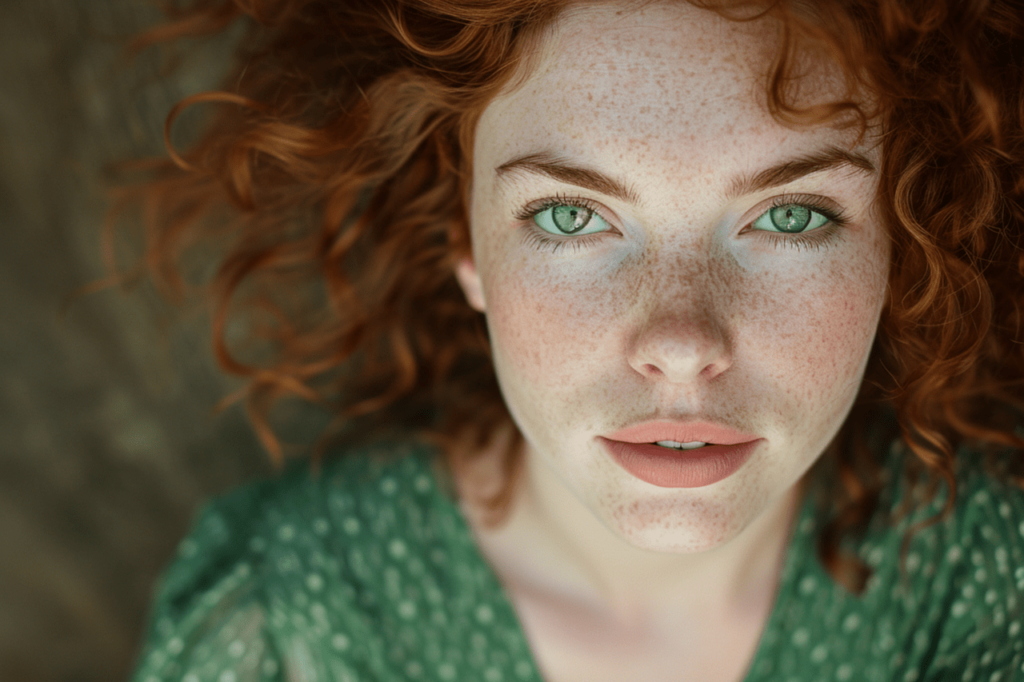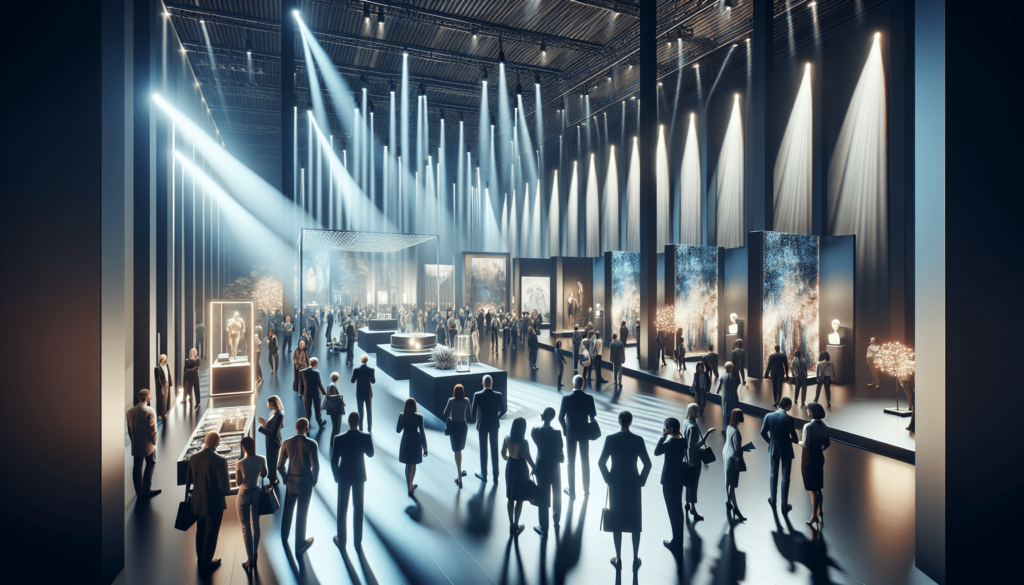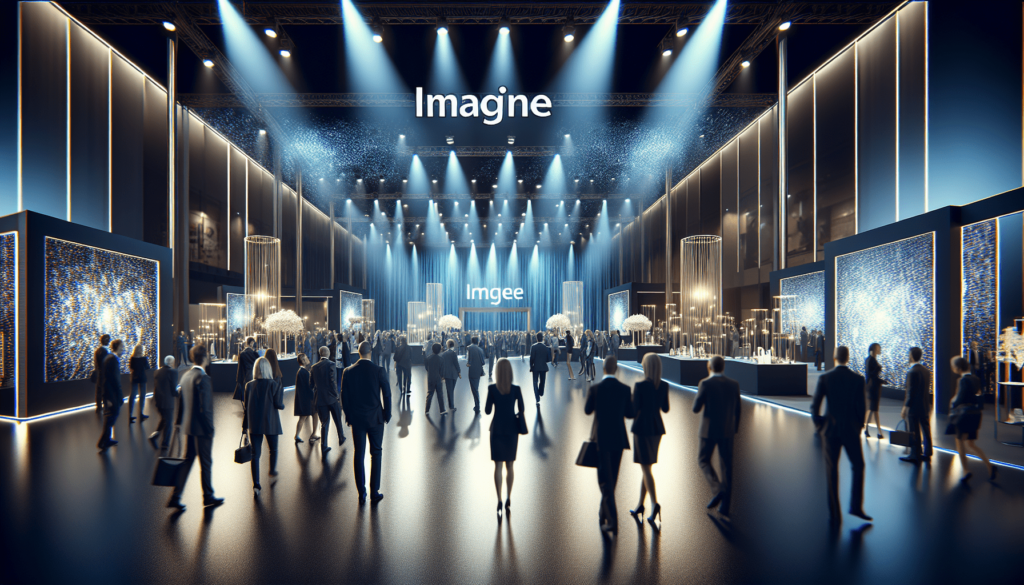Discover the world of sophisticated lighting solutions designed specifically for exhibitions and events. Whether you’re planning an art exhibition, trade show, or corporate event, lighting plays a vital role in setting the stage and creating the perfect atmosphere. From dazzling spotlights that highlight key exhibits to ambient uplights that transform a space, this article explores the endless possibilities of lighting design and how it can elevate your next exhibition or event to new levels of sophistication. Let’s shine a spotlight on the power of light and get inspired by the possibilities it holds.
Importance of Lighting in Exhibitions and Events

Creating the Right Atmosphere
When attending an exhibition or event, one of the first things you notice is the atmosphere. A well-lit space can instantly create a welcoming and inviting ambiance that sets the stage for a memorable experience. The right lighting can transform a dull and ordinary space into a vibrant and captivating environment. By carefully selecting the color temperature, intensity, and placement of lights, you can create different moods and atmospheres to suit the theme and purpose of the event.
Enhancing the Visual Impact
Lighting plays a crucial role in enhancing the visual impact of exhibitions and events. It helps to highlight important features, displays, and artworks, making them stand out and capture the attention of the audience. By strategically positioning spotlights or floodlights, you can draw the eye to specific areas or objects that you want to highlight. The right lighting can bring out the textures, colors, and details of the exhibits, creating a visually stunning display.
Highlighting Key Elements
When organizing an exhibition or event, it is important to emphasize the key elements that you want to highlight. Whether it’s showcasing a new product, displaying artwork, or presenting a performance, lighting can be used as a powerful tool to direct attention and focus on these key elements. By using spotlights or uplighting, you can create a focal point and draw the audience’s gaze towards the desired area. By controlling the lighting, you can guide the viewer’s perception and enhance the overall impact of the exhibits or performances.
Types of Lighting Solutions
Spotlights
Spotlights are a versatile lighting solution that can be used to create focused, intense beams of light. They are perfect for highlighting specific artworks, displays, or performances. Spotlights come in various sizes and can be adjusted to control the beam angle, intensity, and color temperature. They can be ceiling-mounted, track-mounted, or floor-mounted, allowing for flexibility in positioning.
Floodlights
Floodlights are used to provide even and wide-angle illumination over large areas. They are commonly used for outdoor events or to light up wide exhibition spaces. Floodlights can be positioned on the ground or mounted on a mast, depending on the requirements of the event. They provide a high-intensity and uniform illumination, ensuring that the entire space is well-lit.
Uplighting
Uplighting involves placing lights at the base of a wall or object to highlight it from below. This technique is often used to create dramatic effects or to accentuate architectural features. Uplighting can add depth and dimension to the space, creating a visually striking impact. It can also be used to create a sense of movement by placing lights at different angles.

String Lights
String lights are a popular choice for creating a whimsical and festive atmosphere. They are versatile and can be easily hung or draped across the venue. String lights come in various shapes, colors, and sizes, allowing for customization to suit the theme of the event. They can add a touch of warmth and playfulness, creating a cozy and inviting environment for the attendees.
Gobo Lights
Gobo lights use stencils or templates to project patterns, images, or logos onto surfaces. They are often used to add branding or thematic elements to the event space. Gobo lights can be placed on the ground or mounted on fixtures, providing a creative and customizable lighting solution. They can transform plain walls or floors into visually captivating and branded spaces.
Considerations for Choosing Lighting Solutions
Venue Size and Layout
Before selecting lighting solutions, it is crucial to consider the size and layout of the venue. Understanding the dimensions and characteristics of the space will help determine the number and type of lights needed. A large exhibition hall may require floodlights or a combination of spotlights and uplights to ensure adequate and uniform illumination. A smaller booth or enclosed space may only require a few well-placed spotlights or string lights.
Theme and Style
The theme and style of the event play a significant role in determining the appropriate lighting solutions. For a vintage-themed event, warm and soft lighting with string lights or dimmable LED bulbs can create a cozy and nostalgic ambiance. For a modern and sleek event, crisp and bright lighting with spotlights or gobo lights can enhance the contemporary aesthetic. Understanding the desired atmosphere and theme will help in selecting the right lighting fixtures and techniques.
Budget
Budget is a crucial consideration when choosing lighting solutions for exhibitions and events. It is important to allocate resources efficiently to achieve the desired lighting effects without compromising on quality. Researching different lighting options and comparing prices can help in making informed decisions. Additionally, considering the long-term costs of energy consumption and maintenance is necessary for an effective budget allocation.
Energy Efficiency
In today’s environmentally conscious world, energy efficiency is a key consideration for lighting solutions. Choosing energy-efficient bulbs, such as LED lights, can significantly reduce energy consumption and costs. LED lights have a longer lifespan, consume less energy, and produce less heat compared to traditional incandescent bulbs. Incorporating lighting controls, such as timers or occupancy sensors, can further optimize energy usage and reduce waste.
Designing a Lighting Plan

Identifying Key Areas
Before designing a lighting plan, it is important to identify the key areas that require specific attention. These may include exhibition booths, artwork displays, stages, or entrance areas. By prioritizing and focusing on these areas, you can ensure that the lighting design effectively enhances the visual impact and creates the desired atmosphere.
Choosing Lighting Techniques
Once the key areas are identified, it is essential to choose the appropriate lighting techniques to achieve the desired effects. For example, spotlights can be used to highlight individual artworks or products, while uplighting can be used to accentuate architectural features. By selecting the right techniques, you can create a cohesive and visually appealing lighting design.
Collaborating with Designers and Planners
Designing a lighting plan is a collaborative effort that involves working closely with designers, planners, and event organizers. It is important to communicate your vision and requirements to ensure that the lighting design aligns with the overall theme and objectives of the event. By collaborating with professionals in the field, you can benefit from their expertise and create a seamless and impactful lighting experience.
Creating a Lighting Schedule
Once the lighting plan is finalized, it is crucial to create a detailed lighting schedule. This schedule outlines when and how the lights will be installed, tested, and operated throughout the event. A well-organized lighting schedule ensures that the lighting team is aware of their responsibilities and helps in executing the plan efficiently. It also allows for any necessary adjustments or troubleshooting to be carried out in a timely manner.
Using Lighting to Create Different Effects
Illuminating Artwork and Exhibits
In exhibitions, lighting plays a vital role in showcasing artwork and exhibits to their full potential. By using spotlights with adjustable color temperature and intensity, you can highlight the intricate details and textures of the pieces. The contrast between light and shadows can also enhance the three-dimensionality of sculptures and installations. Additionally, using gobo lights to project patterns or logos onto the walls can create a branded and captivating experience.
Creating Drama and Ambiance
Lighting can be used to create dramatic effects and enhance the overall ambiance of an event. By using different colors, intensities, and angles, you can create a sense of depth, contrast, and movement in the space. Dimmed or colored lighting can evoke specific moods or emotions, whether it’s a romantic atmosphere for a wedding or an exciting atmosphere for a concert. Carefully selected lighting techniques can create a memorable and immersive experience for the attendees.

Directing Attention
An effective lighting design directs the audience’s attention to specific areas or objects within the event space. By using spotlights or focused lighting, you can guide the viewer’s gaze towards key elements such as speakers on a stage or new product releases. This helps in providing a clear and organized flow of information and enhances the overall impact of the event.
Making Spaces Feel Larger
Lighting can be used strategically to make smaller spaces feel larger and more spacious. By using uplighting or wall-washing techniques, you can create the illusion of taller ceilings or wider walls. By illuminating the vertical surfaces, you draw the eye upwards, making the space appear larger. Additionally, using mirrors or reflective materials can amplify the effect of the lighting, further enhancing the perceived size of the venue.
Incorporating Intelligent Lighting Systems
Automated Lighting Control
Intelligent lighting systems allow for automated control and scheduling of lighting effects. By pre-programming lighting scenes or sequences, you can create dynamic and seamless transitions throughout the event. Automated lighting control simplifies the operation and management of the lighting setup, allowing the lighting team to focus on other aspects of the event.
Color Changing Lights
Color changing lights offer versatility in creating various moods and themes. By using RGB (red, green, blue) LED lights or gels, you can easily change the color of the lighting to match the desired ambiance or branding. Color changing lights can be synchronized with music or performances for a synchronized and immersive experience.
Dynamic Lighting Effects
Intelligent lighting systems can create dynamic lighting effects, including fading, strobing, or pulsing lights. These effects can be used to enhance the energy and rhythm of performances or to create a dynamic atmosphere during parties or concerts. The ability to change the lighting dynamically adds an element of excitement and anticipation to the event.
Syncing with Music or Performances
Integrating lighting systems with the audiovisual components of an event can create a truly immersive and synchronized experience. By syncing the lighting effects with the music or performances, you can enhance the overall impact and create a multi-sensory experience for the audience. This synchronization adds depth and coherence to the event, leaving a lasting impression on the attendees.
Technological Advances in Lighting Solutions

LED Lighting Technology
LED lighting technology has revolutionized the exhibition and events industry. LED lights offer numerous advantages over traditional lighting solutions. They are energy-efficient, have a longer lifespan, produce less heat, and provide a wide range of color options. LED lights can be easily controlled, allowing for creative lighting effects and versatility in design. The technology continues to advance, with improvements in brightness, color accuracy, and controllability.
Wireless and Battery-powered Lights
Wireless and battery-powered lights provide flexibility and ease of installation in various settings. They eliminate the need for extensive wiring and allow for greater freedom in positioning the lights. Wireless lights are particularly useful for outdoor events or temporary installations where traditional power sources may not be readily available. Battery-powered lights also provide a portable lighting solution for exhibitions or events on the move.
Smart Lighting Systems
Smart lighting systems incorporate advanced features such as motion sensors, occupancy sensors, and remote control capabilities. These systems offer enhanced energy efficiency by automatically adjusting the lighting levels based on occupancy or natural light levels. Smart lighting systems can be controlled remotely through mobile apps or web interfaces, providing convenience and flexibility in managing the lighting setup.
Overcoming Lighting Challenges
Dealing with Limited Power Sources
In outdoor events or unconventional venues, limited power sources can pose a challenge for lighting setups. However, by using battery-powered or wireless lights, you can overcome these limitations and still achieve the desired lighting effects. Additionally, utilizing energy-efficient LED lights can reduce the power requirements and allow for a more sustainable lighting solution.
Managing Glare and Shadows
Glare and shadows can disrupt the visual experience and diminish the impact of the lighting design. By carefully choosing the positioning and angles of the lights, you can minimize glare and shadows. Using diffusers or filters can also help to soften the light and achieve a more even illumination. Regular testing and adjustments are crucial to ensure that the lighting design is optimized and any glare or shadows are effectively controlled.
Weather-proofing Outdoor Lighting
Outdoor events bring the challenge of unpredictable weather conditions. Protecting the lighting equipment from rain, wind, or extreme temperatures is essential to ensure proper functioning and safety. Using weatherproof or IP-rated lighting fixtures and accessories can help to withstand various weather conditions. It is also important to have a contingency plan in case of adverse weather, such as temporary covers or alternative indoor spaces.
Ensuring Safety and Compliance
Safety is paramount when it comes to lighting for exhibitions and events. It is important to comply with local regulations and guidelines regarding electrical safety and fire hazards. Regular inspections and maintenance of lighting fixtures, cables, and connections are necessary to ensure proper functioning and minimize the risk of accidents. Training the lighting team on safety protocols and emergency procedures is crucial for a safe and successful event.
Sustainable Lighting Practices
Using Energy-efficient Bulbs
One of the most effective ways to promote sustainability in lighting is by using energy-efficient bulbs. LED lights are a popular choice due to their low energy consumption and long lifespan. Compared to traditional incandescent bulbs, LED lights can save a significant amount of energy and reduce carbon emissions. By choosing energy-efficient bulbs, you can contribute to a greener and more sustainable event industry.
Implementing Lighting Controls
Lighting controls, such as occupancy sensors, timers, or dimmers, are essential in minimizing energy waste. By automatically adjusting the lighting levels based on occupancy or utilizing natural light, you can optimize energy usage. Lighting controls also allow for customization and flexibility, enabling you to create the desired ambiance or effects while still conserving energy.
Optimizing Natural Light
Incorporating natural light into the lighting design can reduce the reliance on artificial lighting and save energy. Using skylights, windows, or glass walls can maximize the use of natural light during daytime events. Additionally, positioning the exhibits or stages strategically to take advantage of natural light can create a unique and dynamic lighting experience.
Reducing Light Pollution
Light pollution is a growing concern that affects the environment and biodiversity. To minimize light pollution, it is important to focus the lighting downward and contain it within the event space. By using shields, diffusers, or directional lighting, you can reduce the amount of light that spills into the surrounding areas. Responsible lighting practices not only reduce light pollution but also enhance the overall experience for the attendees.
Case Studies: Successful Lighting Solutions for Exhibitions and Events
Case Study 1: Museum Exhibition Lighting
In a museum exhibition, lighting plays a crucial role in presenting artworks and artifacts in a visually captivating manner. By using a combination of spotlights and uplights, a museum can create a dramatic and immersive experience for visitors. Precise positioning of the lights highlights the details and textures of the artworks, while controlling the color temperature sets the desired mood. Lighting controls and automation allow for seamless transitions and customized lighting effects throughout the exhibition.
Case Study 2: Trade Show Booth Lighting
A well-lit trade show booth is essential for attracting attention and engaging visitors. By using spotlights, floodlights, and gobo lights, exhibitors can effectively showcase their products and create a visually stunning display. Highlighting key elements with focused lighting and incorporating branding through gobo lights can leave a lasting impression on potential customers. The right lighting techniques can transform a booth into an inviting and informative space, facilitating meaningful interactions between exhibitors and attendees.
Case Study 3: Outdoor Event Lighting
Outdoor events often present unique challenges due to weather conditions and limited power sources. By using battery-powered and wireless lights, organizers can overcome these challenges without compromising on the lighting experience. String lights, floodlights, and color changing lights can create a festive and vibrant atmosphere for outdoor events. Planning for weather-proofing measures and adhering to safety regulations are crucial to ensure the success and safety of the event.
In conclusion, lighting plays a vital role in creating the right atmosphere, enhancing the visual impact, and highlighting key elements in exhibitions and events. By carefully selecting suitable lighting solutions, considering various factors such as venue size, style, budget, and energy efficiency, and designing a comprehensive lighting plan, organizers can create memorable and impactful experiences for their attendees. Incorporating intelligent lighting systems, embracing technological advances, and implementing sustainable lighting practices further enriches the event industry. Through case studies, we have seen successful lighting solutions in museum exhibitions, trade show booths, and outdoor events. By understanding the importance of lighting and utilizing the appropriate techniques, the exhibition and event industry can continue to captivate and inspire audiences.



